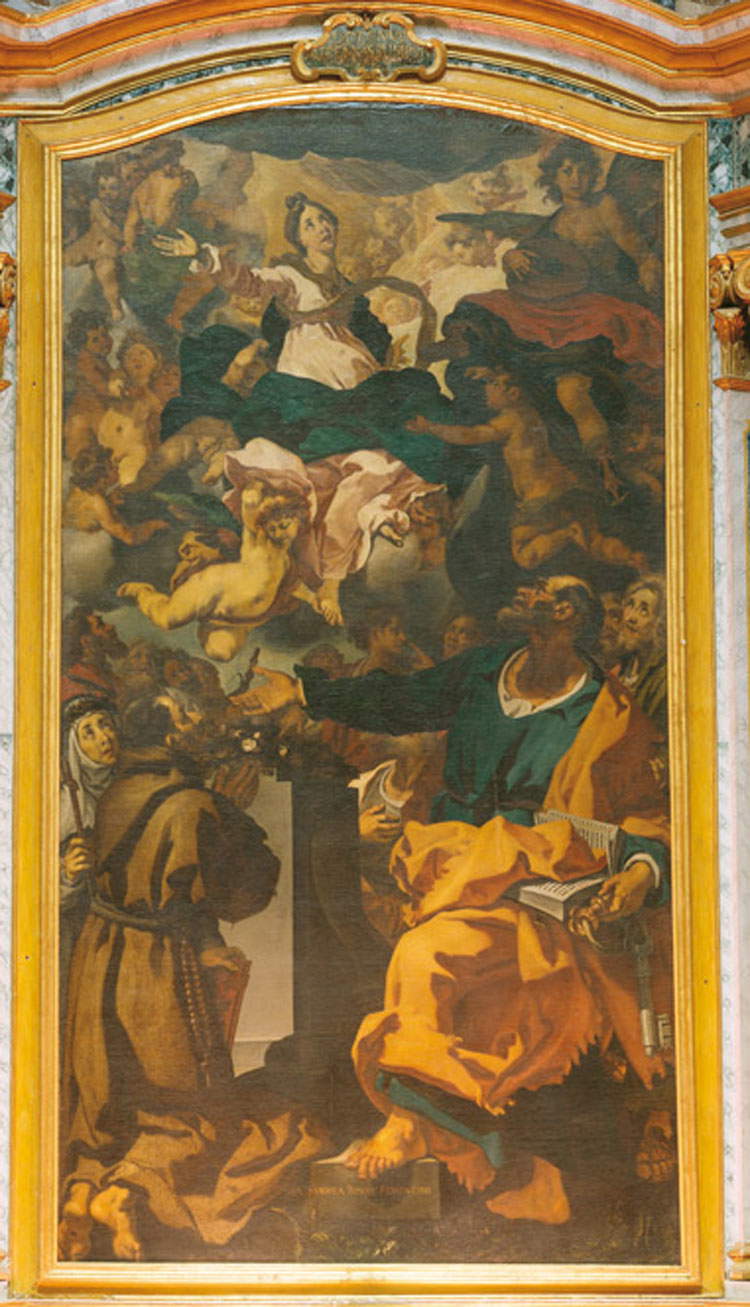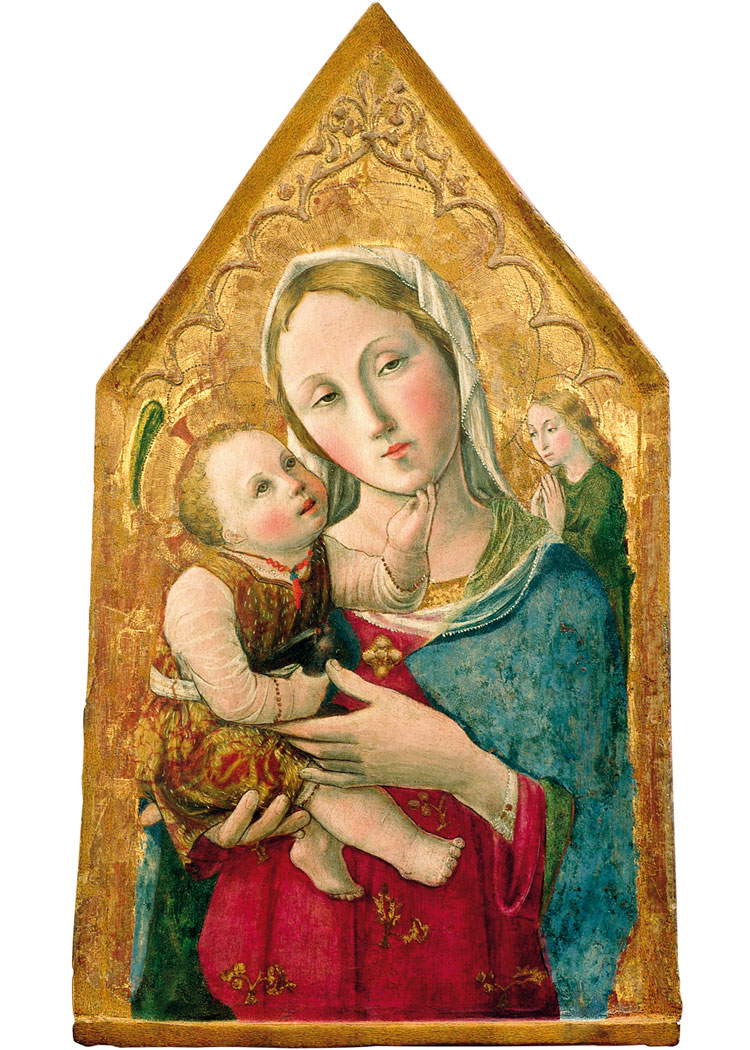by Ilaria Baratta , published on 20/05/2017
Categories: Exhibition reviews
/ Disclaimer
Review of the exhibition Let's Hurry! Marche 2016-2017: treasures saved, treasures to be saved, at the Uffizi until July 30, 2017.
When the earth shakes, it leaves indelible marks on people and places: the terror of reliving those tragic moments, during which the sense of helplessness predominates and the despair over the loss of what is part of affection and everyday life is almost impossible to eradicate, takes over the present and clouds even memories; the places that until a moment before belonged to the life of communities are destroyed and defaced, and the artistic beauties enclosed in them deeply wounded by the devastating force of nature, which seems unstoppable.
However, the feelings of terror and despair are then succeeded by a strong desire for rebirth, a great urge to rebuild everything that was lost in a few moments, so that we can return to normalcy, despite the fact that it is not possible to totally erase what happened. This desire for rebirth also passes through art: thus, thanks to the work of firefighters, Carabinieri, Army soldiers, Superintendence personnel and Civil Defense volunteers, much of the artistic heritage of the areas affected by the earthquake is saved from destruction. The works of art secured and transferred to storage facilities should not be forgotten. And such is precisely the goal of the exhibition “Let’s hurry! Marche 2016-2017: treasures saved, treasures to be saved,” which until July 30 occupies the Aula Magliabechiana of the Uffizi Gallery: not to allow oblivion to make invisible, or worse, to make forgotten the works of art that were saved from destruction caused by the earthquakes that in August and October 2016 wounded Central Italy, particularly the region of Marche, and thus to protect with “fame” the affected artistic beauties. Only continued interest in them by scholars and the community, as Gabriele Barucca argues in his essay, can prevent them from falling into oblivion. It is a principle that to Barucca recalls a passage from a letter written by Roberto Longhi in 1944 to his young friend (and future great scholar) Giuliano Briganti in reference to the bombing of Bologna occupied by German troops: “Art, in itself mute and defenseless, can only protect itself with fame, and fame is the criticism always aroused.” This is how Longhi urged dissemination of the values to be protected, referring to Bologna’s war-affected monuments.
 |
| Entrance to the exhibition Facciamo presto! |
 |
| First hall of the exhibition Facciamo presto! |
For the Uffizi exhibition, a great example of valuing and protecting works of art that have had to endure great hardship, as well as that strength that comes from the strong desire to begin again despite adversity, masterpieces belonging to different genres and fields and created with the most varied techniques and modes of expression were selected: paintings on wood and canvas, wooden sculptures, goldsmithing, textiles and manuscripts. Works chosen to represent the treasures of the entire Marche region affected by the seismic phenomena, namely the area of the southern hinterland of the region, which were located, in most cases since their origin, in churches, palaces and museums now destroyed or uninhabitable.
The works on display are mainly religious in theme: welcoming us is the altarpiece depicting the Annunciation with Christ in Pieta in the lunette above, painted in about 1455 by Giovanni Angelo d’Antonio, one of the major painters of the Camerte fifteenth century, and which comes from the Pinacoteca Civica di Camerino (Macerata). The painting has not been damaged, so it is possible to see the fine decorations on the architecture, on the wings of the announcing angel and on the garments of the characters.
Another well-preserved masterpiece is Marco Palmezzano’s large altarpiece depicting in the central panel the Madonna Enthroned between Saints Francis and Catherine of Alexandria, and in the lunette the Pietà (1501) from the church of San Francesco in Matelica (Macerata). A work where Venetian influences are very clear in the choice of colors, the expressions of the characters and especially in the detailed background that recalls the backgrounds of Giovanni Bellini’s paintings.
 |
| Giovanni Angelo d’Antonio, Annunciation with a lay donor and a Franciscan tertiary donor (Giacomo di Boncambio and his wife?) (c. 1455 or 1456; tempera on panel; Camerino, Pinacoteca Civica) |
 |
| Marco Palmezzano, Madonna Enthroned between Saints Francis and Catherine of Alexandria (1501; oil and gold on panel; Matelica, Church of San Francesco) |
Not so fortunate was the fate of another work in the exhibition, namely Madonna and Child with Saints Michael the Archangel and Stephen with Pieta between angels above (c. 1490-1500; Vittorino church, Castelsantangelo sul Nera). It is in fact the panel work on display that has suffered the most damage: it is missing some parts, and is ruined in both structure and coloring. Next to the panel, attributed to Benedetto di Marco, a panel has been placed showing it before the earthquake to make visitors understand the severe damage suffered. There are many panels showing the works in their original location or in their lost state or even in their stages of recovery, as in the case of the Assumption of the Virgin with Saints Francis and Clare by Andrea Boscoli (c. 1605), from the church of San Francesco in San Ginesio (Macerata).
Also deprived of their original location are the three bells that resonated before the earthquake from the bell tower of the church of Santa Maria in Carpignano in San Severino Marche (Macerata), and from the church of San Francesco and the Civic Tower in Arquata del Tronto (Ascoli Piceno).
 |
| Benedetto di Marco (?), Madonna and Child with Saints Michael Archangel and Stephen (c. 1490-1500; tempera and gold on panel; Nocria di Castelsantangelo sul Nera, church of San Vittorino) |
 |
| Triptych attributed to Benedetto di Marco before the earthquake |
 |
| Andrea Boscoli, Assumption of the Virgin with Saints Francis and Clare (c. 1605; oil on canvas; San Ginesio, church of San Francesco) |
 |
| Italian foundryman of the second half of the 15th century, Campana (1470; San Severino Marche, church of Santa Maria in Carpignano) |
Other works on display include the cusped panel depicting the delicate Madonna and Child on a gold background by Lorenzo d’Alessandro (1480), which was kept in the church of the monastery of Santa Chiara in San Ginesio, the Madonna Enthroned with Child by Carlo Crivelli from the Diocesan Museum of Ascoli Piceno, Carlo Maratta’s Virgin and Child Appearing to St. Francesca Romana (1655-56) from the church of Sant’Angelo Magno in Ascoli Piceno, Baciccio’s Conversion of St. Paul (1700) from the church of Saints Lawrence and Paul in Fiastra (Macerata).
A fine painted wooden sculpture depicting the Madonna and Child (c. 1490-1500), made by the Master of the Madonna of Macereto and from the Museo Civico Diocesano in Visso, captures the visitor’s gaze because of the feeling of love and tenderness between a mother and child that it conveys.
Representing the highest goldsmithing is the marvelous Reliquary of Montalto decorated with precious stones, pearls, gold and cameos, while almost at the conclusion of the exhibition itinerary it is possible to contemplate the autograph manuscript of Leopardi’s Infinity from the Museum of Visso. A selection of works from the Middle Ages to the 18th century from the areas of the Marche affected by the earthquake so as not to allow oblivion to invade the treasures saved and to be saved.
 |
| Lorenzo d’Alessandro, Madonna and Child (1480; tempera on panel; San Ginesio, church of the monastery of Santa Chiara) |
 |
| Carlo Crivelli, Madonna Enthroned with Child known as Madonna of Poggio di Bretta (after 1470; tempera on panel; Ascoli Piceno, Museo Diocesano) |
 |
| Carlo Maratta, The Virgin and Child Appears to Saint Francesca Romana (1655-1656; oil on canvas; Ascoli Piceno, church of Sant’Angelo Magno) |
 |
| Giovan Battista Gaulli known as Baciccio, Conversion of St. Paul (c. 1700; oil on canvas; Fiastra, parish church of Santi Lorenzo e Paolo) |
 |
| Attributed to Jean du Vivier, Reliquary of Montalto (gold, gilded silver, enamels, precious stones, pearls, sardonyx cameo; Montalto Marche, Museo Sistino Vescovile) |
 |
| Master of the Madonna of Macereto (Lucantonio di Giovanni Barberetti ?), Madonna and Child, detail (c. 1490-1500; carved and painted wood; Visso, Museo Civico Diocesano) |
 |
| Leopardi’s Manuscript of the Infinite |
Warning: the translation into English of the original Italian article was created using automatic tools.
We undertake to review all articles, but we do not guarantee the total absence of inaccuracies in the translation due to the program. You can
find the original by clicking on the ITA button. If you find any mistake,please contact us.














